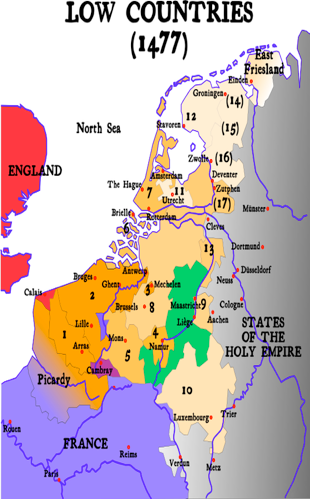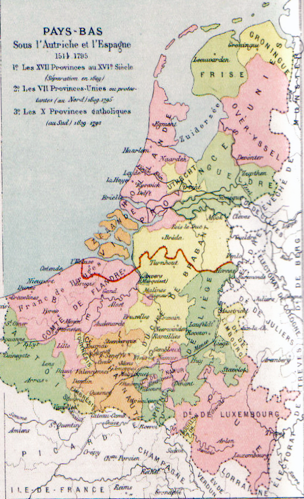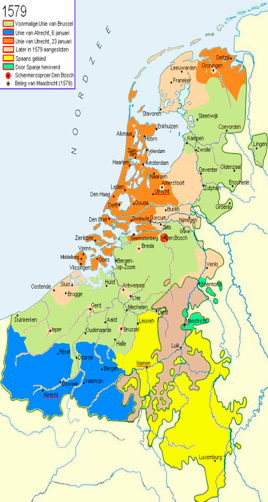1/. IntroductionDownload
1.1/ History and Geography of the Surname (including the period before its adoption)
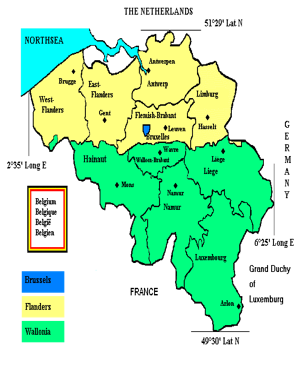
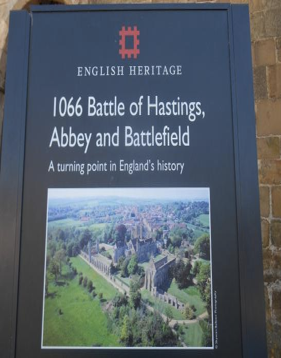
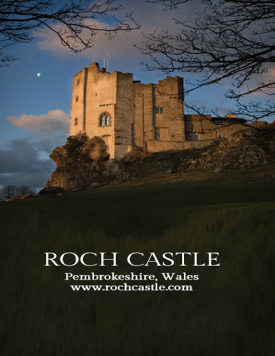
In historical terms the surname has been associated with the Anglo-Norman Invasion of Ireland. This invasion was initiated as a conquest of the south of the Province of Leinster (one of 5 Irish Provinces). It was executed from South Wales through Ireland's south eastern region, essentially through what later came to be known as Waterford & Wexford Counties, between the years 1167 and 1171. The full conquest of the whole country was not really completed till the end of the first Elizabethan Reign (begun 1558) in 1603. This was accompanied at the time by the flight overseas of the ruling Irish ‘Earls’. Between these two periods, the writ of the English Crown swung back and forth across the country, depending on the influence and military superiority of the core stronghold of English Administration (later British Administration), centred on Dublin Castle. The centralised and Anglicised core region of colonial rule, that which surrounded Dublin City, was known as the Dublin Pale. The objective of the information provided in this presentation is to clarify the probabilities of the surname's origins prior to its appearance in Norman Ireland. The surname's source has historically been considered to be from one of the following three regions: Anglo-Saxon England, the Comté of Flanders in Belgium (Comté being a Count's realm or county), or possibly the Duchy of Normandy in northern France.
Like many surnames Sennett and its variant surnames has an ancient history. Tracing the surname tells a fascinating historical tale, one that has now reached many parts of the world in many different ways. The surname is probably accurately described as generally uncommon. It is certainly one of those many less common surnames other than in Wexford County. One could equally add however that it is now present in some numbers in the County of Dublin and many other major Anglophone cities such as Liverpool, London, Melbourne and New York, and the States of California, New York, Ontario and Victoria in Australia (see mid section Tables, Ch.5.1/). In Wexford, it is particularly common in South Wexford and the ancient Barony of Forth. The surname's earliest appearance in document form in Ireland was in year 1204, north of Wexford Town and harbour, in the Townland of Annamult, Kilkenny County. It should be noted the surname was also recorded in Latin script (and possibly Anglo-Saxon) in England before this date. These citations of the surname were all in Latin and on all but one known occasion, followed the first phase of Duke William's Norman Conquest of England at the Battle of Hastings (1066). The chronological order of early documentation of the surname has caused a degree of difference of interpretation to date, one that is hopefully fairly covered in Chapters 2, 3 and 4 in presentation of the history to follow. The objective of this history is to give the surname the full context of its historical span. It might also give a wider sense of order to its dispersion throughout the global Anglosphere and Francophone Canada (or French Colonial Departments).
UK (4 Home Nations) and the USA
The surname has a low incidence in Great Britain, being more common in Lancashire/Merseyside, London and the larger English conurbations. A fuller analysis of the all-variant British distribution pattern is provided in Chapter 1.2/. Outside the home nations of Ireland (pre-1922, post-1922 see Ch.5.5/), England, Scotland and Wales the presence of the surname reflects the old routes of British Isles’ or European mass migration to America and the old British Dominions (see below). In the USA, the surname's all-variant absolute incidence is more particular to New England and the mid-Atlantic States, the old industrial Great Lakes States, and the emergent 19th Century states of Texas, California and Washington. One can utilise data from the US Census Bureau or websites such as
In terms of absolute numbers, the incidence of the surname in recent-period telecom directories or Census returns show greater populations for the ‘aggregated’ surname outside of Ireland, in both the USA and UK. There is a substantially greater incidence in the USA than in Great Britain. A look at the British incidence and pattern of dispersion is provided further below in Ch.1.2/ and also in the mid-section household and population tables of Chapter 5.1/. Overall Irish migration patterns are similar-to but not exactly aligned with the earlier mass English, Scottish & Ulster Scots migrations of the 17th &18th Centuries. Historically, the streams of both Scotch-Irish and Catholic Irish emigration to North America made it a far larger cultural nucleus of Irish identity than the island itself. The parallel Hiberno-British or Ireland/Great Britain relationships have always been slightly stranger and at times on either or both sides, distant subjects of amity or enmity. An unexpected feature of the relationship is the fact that there are far more British citizens with an Irish grandparent in Great Britain than there are Irish citizens in Ireland. Such case might be a normal expectation in the US, not in GB.
British Dominions
Among the old British Dominions there is an identifiable but lesser incidence than the USA in Canada & Australia, this latter country being where a notable 19th Century “pastoral squatter”, Captain Walter Synnot, has many proud direct descendants. In Canada the surname is now found in all the Provinces. In 18th and 19th Century Canada, it became more established in the Maritime Provinces and along the St Lawrence toward Quebec, Montreal, Toronto and the Great Lakes. The existence of Francophone Sennetts may seem unusual or unexpected but it should not be so. In Quebec and elsewhere some short-version variants of Sennett surname are attributed to a French or continental European source origin. The French language and the surname should be no strangers, this fact hopefully further illuminated below. Regarding Canadian Sennett families, it must be remembered that the family of Hollywood's earliest impresario, the manically hard-working Mack Sennett (originally Sinnott), migrated from Wexford to mid 19th Century Quebec. His family was probably unfortunate, given the high risk of death and disease facing mass inward migration along the St Lawrence in mid 1840s. The family subsequently moved to New York before Mack himself uprooted again for the City of LA and Hollywood.
In Australia, Sennett appears mostly in Victoria, New South Wales and Queensland. It is also found in both North & South Islands of New Zealand. In South Africa, while the surname is most sporadic if present at all, there remain a sprinkling of ‘Synnot’ place-names and a most charming selection of botanical wildflowers native to the Cape. Their names derive from the above mentioned Armagh born Captain Walter Synnot. He lead an expedition and British Government sponsored land settlement scheme to the Western Cape in 1820. There had been a nationwide economic depression in Britain after the conclusion of the Napoleonic Wars. The important Battle of Waterloo, the final curtain for the Napoleonic era, was in 1815.
Ireland and elsewhere
Apart from the regions already noted above, Britain, North America and the old Dominions, the surname in current times can also be found in some form or degree in the Benelux countries and also in Latin America, particularly Brazil. In Ireland itself the nationwide national census/censii overall has only in recent decades emerged from more than a century of absolute shrinkage. This decline is true also for the particular Irish Sennett cohort over this multi-generational period of more than 100 years. While the surname is now almost nationwide throughout Ireland it remains most concentrated in Wexford County and the Dublin County commuter belt. The overall surname-population incidence is slightly lower in Ireland than in Grrat Britain. Some indication of absolute incidence (populations) in Ireland is provided later in the section Table of Ch.5.1/.
Sennett Genealogy: Historic Record
Generally worldwide, although individual families may be attached to their own famililar spelling format, to project any particular or historic spelling option back beyond a mid 19th Century period might be unjustified. The spelling formats prior to the mid 19th Century and Famine period (1840s) have seemed to be fairly fluid.
In America there were a number of Sennett family genealogies produced in the period preceding and around the period of the First World War. There were few (or none) such pre-Great War attempts at chronicling Sennett history or family genealogies in Ireland or Britain or other parts of the Anglophone world up to this period. The vacuum of family line material on this side of the Atlantic left a void of genealogical exposition or interesting family history to inspire or inform those unfamiliar with their surname among any of an enquiring Sennett micro-public. This gulf exempts of course the high-end promotional volumes produced by Burke's Peerage Ltd (and also Debrett's Baronetage and Knightage) or their predecessor companies, and secondly the more middle-brow general Surname Dictionaries. The former were limited in scope while the many limitations of the latter were chiefly that they were so ill-informed. Hence the need now to attempt correction of what seems now the muddled contortions of the Surname-Dictionary publishing universe.
So it was that for a period of the last 100 years, should one wish to see, read or appraise a Sennett genealogy, one had cause to turn to US Public Library sources or trawl widely for the existence of such, most probably through the network library services of the Utah State based Church of Jesus Christ of Latter Day Saints. One can't bake a cake from a very bare cupboard. The cupboards of Ireland were long ago picked clean or thrashed as regards Sennett genealogical material. Historically there were however many official documents going back to the end of the 12th Century in the Dublin Administration's Public Record Office. This was the British Government's or Dublin Castle's Irish Administrative repository, located at the Four Courts Building in the City's centre (destroyed at the outbreak of Irish Civil War, in April 1922). Any other private repository of Sennett genealogical information was most likely non-existent post the Cromwellian period. However, there was one notable exception to this general rule of a barren family-history or genealogical landscape on this side of the Atlantic. There was one Synnott family and two professional Wexford historians, the Hores ‘pére et fils’, who by the turn of the 19th Century had spent 2 or 3 lifetimes quietly working from official sources on the local and family history of their acquaintance in South Leinster and Wexford. As is often the way in these things, collective but independent effort can bear its fruit together in the timely manner of season after long lying fallow. The series of three American Sennett genealogies were recounted and published between 1905 and 1920. The Hore family's Wexford History Volumes were 1st published between 1900 and 1911.
The Hore family, father and son HF Hore (Herbert) and PH Hore (Philip Herbert), had been researching Wexford and Irish history for most of their lives (and before the destruction of much National and ancient Public Manuscript material in 1922, destroyed during a bombardment that accompanied the 1st shots of the Irish Civil War). Subsequent to the death of Hore Senior, the younger Philip Herbert completed the opus of their joint effort and began the sequence of publication of his 6 Volume work ‘A History of the Town and County of Wexford’, all published after 1900. There were to be 7’ Volumes in the set. Despite the deficit that remained, the History of Wexford or Hore's History would become a magisterial and standard setting work.
Nicholas J Synnott
(of Furness, Kildare County. Not the Congressman Nicholas J Synnott of Oregon State, 1912-1920) Somewhat in synchrony with this broader effort above was the ongoing private labour of a Nicholas J Synnott of Furness, Kildare County. He contributed to the producion the first serious Sennett type genealogy on this side of the Atlantic. While the Manuscript format “Pedigrees and Records of the Synnotts of County Wexford” was completed in 1913, its proper publication was delayed until the later editions of Burke's work. It bore within a great weight of learning from the historical knowledge of the Hore family (especially Philip Herbert Hore) who had been long before commissioned to pursue such work by Nicholas Synnott. His Manuscript would ultimately be used to inform the genealogical framework contained in Burke's Irish Family Records or ‘Landed Gentry of Ireland’ 1958 and 1976, but not however those earlier of 1899, 1904, and 1912. (Ch. 5.6/)
For both works, Hore's ‘History of the Town and County of Wexford’ of 1900 and thereafter, and the Synnott pedigrees in ‘Irish Family Records’ of 1976 (the original manuscript form composed 1913), please see Chapter section 5.6/ throughout. The 20 year era of a flowering of American (in USA, 6) & Irish (1, possibly 2) family trees occurred 250 years after Cromwell's visit. Such long delay probably due to his short and close embrace.
1.2/ Surname Identity, a Modern Conundrum and some recent Y-Chromosome DNA.
So, the surname has been and could be described because of its known history at various times (as here after presented), as being common in Wexford, so it is therefore Wexfordonian. As will later be partly or fully evidenced it could be equally classified as being within each of the following descriptive terms,
- Irish-hyphenated typology
Hiberno-English, Hiberno-Flemish, Hiberno-Norman, Hiberno-Welsh, Hiberno-Cambric, Anglo-Irish/Hiberno-English/British Cambro-Irish, Norman-Irish, Franco-Irish, Flemish-Irish. - By Nationality
Irish, English (Yes, but Anglo-Saxon ?), Old-English (in Ireland only), Welsh, British, Norman, French, Flemish (Flanders, Belgium), Dutch (speaking). - Other hyphenated forms
Anglo-Norman, Cambro-Norman, Cambro-Flemish, Franco-Norman, Franco-Flemish, Gallo-Norman, Gallo-Flemish, Cambro-Norman-Flemish, Cambro-Norman-Flemish-Roman. Cambro-Norman-Flemish-Balkan
All these terms above are in a way conventional, justifiable and fairly verifiable in an historical sense. One may to some extent say that, given the sweep of the surname's history, the Sennet surname is ‘monogenetic’ in character and origin in a scientific sense to date. The different descriptive terms quoted, tell much the same story really! One can therefore pick one's own geographical typology or definitional description without much fear of contradiction. There is an exception to this ease and interchangeability of the terminology however.
All the above terms are for the most part correct in some way or other. This is especially so in the sense that none of them are absolutely and totally wrong in all ways. They all represent extracts of the history and migration of the surname. There is an additional possibility that the term Anglo-Saxon could be appended to the above list. The inclusion however may be questioned or doubted by some. While the addition would seem to be quite justified and merely a simple addition to a long list, an Anglo-Saxon attribution adds a duality or multiplicity to the supposed source of the ‘current’ surname, as we know it. Surnames need not of course be singular in origin, some surnames can have multiple origins, they can be ‘polygenetic’. However such an attribution might be said to be unverified and unproven or speculative, in its current genetic sense, to some extent. This restrictive supposition or speculative doubt only holds as being a reasonable reservation and a justified scientific deduction up to the present time, as at 2018.
A record and manuscript representation of the Sennett-type surname certainly does occur in surviving Anglo-Saxon and medieval period documentation in England. It appears in a variety of forms, Anglo-Saxon and Latin, and Middle-English script, and in a variety of places. The instances of these records may suggest a series of quite unrelated, unconnected and independent occurrences of the name, what can be referred to as a polygenetic origin in its etymology. The period scarcity may also be due to a paucity of known written records. The discovery of a proper and purist Anglo-Saxon point of derivation of the surname would reasonably direct the conclusion that the modern surname most probably has two (or even more) separate and unrelated geographic sources. It points to the probability of converging twin-tracks of medieval emergence and parallel origin, both, in Ireland (Cambro-Flemish), and also in England (Anglo-Saxon). Some unclear mystery still remains however. The Anglo-Saxon derivation does not appear to have one explicit place of origin (& history), as in Ireland. It consequently has as yet no single and identifiable Anglo-Saxon (English) Y-Chromosome DNA marker or haplogroup, as in Wexford. A single point of origin is a prerequisite to a single common Y-DNA footprint. These two missing pieces in the Anglo-Saxon jig-saw provide the conundrum, the absence of a distinctive DNA marker, and an absence of a certain/particular location. This state of play may change in time.
Generally, the descriptive terminology for the surname has been different in different places at different times. It is most probable that if one wished to describe only the surname's origins or history before modern times, one might use the last-but-two term above with confidence, ie., “Cambro-Norman-Flemish”. The Cambro highlights the historic association with Wales (Cymru or Cambria), Norman or even Anglo/Norman, its association with Normandy (Normandie) in northern France and the Norman Conquest of England, and finally then Flemish. This Flemish terminology finally, because Duke William of Normandy, that is King William 1st of England, also known as William the Conqueror, had close association and an alliance with Flanders. Flanders or Vlaanderen, also known in the period as the Comté de Flandre in Medieval France (and in Latin script as Flandria), held this Norman-Flemish affinity through firstly a geographic proximity and Ducal alliance, and secondly, through an aristocratic marriage. Duke William, a descendant of the pioneer Viking settler ‘Rollo of Normandy’, married Matilde of Flanders in 1051. Matilde was a daughter of the Count of Flanders, Count of the Comté de Flandre. Flanders is the Flemish speaking (Dutch speaking in the Netherlands), region of north-western Belgium, that zone between north eastern France and the Netherlands. In more ancient times Flanders comprised all of the low lying coastal strip between Calais or the ‘Pas de Calais’ in northern France, and the Scheldt/Schelde River estuary on the Belgian-Dutch border at Antwerp (Antwerpen or Anvers). The region comprised a peripheral boundary and buffer zone of the Belgae tribe and the old Roman Empire in Gaul. It was the border area with the Germanic tribes across the Rhine to the east (the Rhine enters the North Sea at the primary Dutch port of Rotterdam).
Conventionally, the surname derivation has been attributed to or associated with the following areas: the Irish counties of Kilkenny, Waterford, and Wexford; and also Norman Ireland, Anglo-Saxon England, Norman South Wales and Pembrokeshire (Dyfed), Normandy, France, and the medieval Flemish (Dutch) speaking region of Flanders in northern Belgium and the nearby border region of north eastern France.
The Conundrum between Origin(s) in Ireland and/or Great Britain (the Home Nations)
The name can be found with some density throughout the south east of Ireland, in all of Wexford County, and to a slightly lesser extent in Dublin County. Currently, it is known and present throughout all of Ireland, in many counties of the 4 Provinces of Leinster, Munster, Connaught and Ulster. It is found to a slightly greater degree of aggregate incidence throughout Great Britain. It is spread all around the UK however, only as regards the particular and more common ‘Sinnott’ spelling (the modal form). In Britain, there is now as was the case in the late 1800s, the highest incidence of this surname variant around the Merseyside region (Sinnott in Cheshire and Lancashire, Liverpool, Manchester, Preston) this all being largely a post-Famine presence. To some degree the fuller variations currently appear in the more populous areas of London (Sinnott & Synnott), the Home Counties (Middlesex, Surrey, Bedfordshire, Berkshire, Buckinghamshire, Hertfordshire, Kent & Essex: Sinnott), Hampshire & the Isle of Wight (Sinnatt & Sinnott), Oxfordshire (Sinnott), Cambridgeshire (Sennitt), in the West Country (Devon & Cornwall: Sennett & Sinnott), in South Wales (Pembrokeshire/South Dyfed, Carmarthenshire, Glamorgan and Monmouthshire/Gwent: Sinnett & Sinnott), in both the East Midlands (Derby, Leicester, Nottingham) and West Midlands (Birmingham, Coventry, Wolverhampton: Sinnott), Yorkshire (Sennett in the old West Riding and North Yorks., Sinnott in South Yorks.), and the North-East, Tyne & Wear, Newcastle and Durham County (Sinnott & Sennett).
As regards the surname's presence in these home islands, this descriptive presentation will try to clarify a current confusion regarding 3 possibilities of the surname's true origins. The 3 potential surname sources are,
- Wexford, following forebears’ progression through a Cambro-Anglo/Norman-Flemish arc of military history.
- A Hertfordshire, Cambridgeshire or East Anglian forebear's emergence (between Roman Britain & 11thCentury).
- Surname convergence of those 2 (or more) separate, independent, unrelated, and coincident forebear's.
It was the period between the Norman Conquest of England and Norman Conquest of Ireland in the mid 12th Century, when surname usage first emerged in Anglo-Norman culture. Real surnames were absent until then.
This presentation attempts to establish and illustrate the following 3 propositions of likelihood, that of,
- A Wexford hinge point of name origin is a strong, or the strongest probability, supported by current Y-DNA.
- An Anglo-Saxon origin has some possibility of emergence in England (without Y-DNA evidence at present).
- A dual/multi-point origin in these home islands, with possible convergence in surname spelling convention.
Firstly, a Norman-Flemish militarised group, who proceeded to cluster in Wexford, having migrated through Wales (a Cambric funnel), after participation in the Norman Conquest of England, and whether the current surname, globally, is exclusive to such an origin.
Secondly, whether the Wexford-clustered surname is actually a derivation from an earlier Anglo-Saxon origin, which migrated to Wexford via the Anglo-Norman settlement (an unlikely early presence at the time), or by other later civilian or military/mercenary migrants from the East Anglian or Home counties (the Saxon south).
Thirdly, the Wexford surname clustering and source is unconnected and unrelated, but additional to, another coincident Anglo-Saxon origin in England, before the Norman Conquest of England by William the Conqueror.
Regarding this analysis, the region of East Anglia on the English east coast is an unknown but critical area in Britain in regard to the current understandings of the surname's origins. It is a region that might be an historical vector point for its potential Anglo-Saxon identity or source. The possibility of such a source is as yet unconfirmed by any especially explicit genetic classification (by incidence, frequency or clustering), these being the characteristic features which might define and demarcate a specific and alternative surname origin to that of Wexford. Future research or sample testing in northern East Anglia, specifically the counties of Cambridgeshire, Norfolk and Suffolk may assist in this instance. These 3 counties recently showed a “Sinnott” variant aggregate household number of between a dozen -to- twenty households collectively (from among the available public directories). Globally and in Wexford, the “Sinnott” format is by far the most common spelling variation, as opposed to the Sennett, Sennitt, Sennott, Sinnett or Synnott forms or the many other surname variants (Sennitt is the more common variant in Cambridgeshire). The East Anglian measure of “Sinnott” frequency was taken at a point of time just before the turn of the millennium in the era of fixed-line directories (prior to mobile or smart phones). This modest regional frequency was as normal a weighting in the distribution spectrum as may be expected in rural England, given it fitted well and quite conventionally with the other rural English regions, by county (or shire).
In Scotland the surname is found around Glasgow (Synnot/t & Sinnott) and the counties of the Strathclyde region, especially Lanarkshire, and also without question the West Lothian region. The name has also occasionally been found in some form in the Channel Islands since the late Victorian period (Artillery Garrison).
Overall throughout the UK, the public directory evidence shows a surname with a more urban concentration pattern, the pattern one would expect from a largely Victorian or earlier period of inward migration from Ireland (especially Wexford). For instance, a surname distribution sampling in that large neighbouring county of Lincolnshire to the north of East Anglia, on its own reveals a rather similar incidence to that aggregate figure as mentioned earlier in the three Anglian shires (for the ‘Sinnott’ format alone). East Anglia historically had been an early Anglo-Saxon region of settlement in “Angle-land”. This migration occurred between the period from the end of Roman Britain in the early 5th Century (c. AD’410 ) and the commencement of the Viking Age, begun in the late 8th Century (@ Lindisfarne Island, AD. 793, and lasting really until the mid 11th Century).
The normality of the surname's distribution pattern in the Anglian region pertains despite there being in Cambridgeshire itself another more popular variant of the family name's spelling. The surname usage in Cambridgeshire currently reveals a more particular incidence of the “Sennitt” format of spelling. At this point it might be noted also from a regional perspective, that in Pembrokeshire, South Wales for example, the most popular format of the current surname has often been spelt “Sinnett”. The spelling format can vary regionally and still conform to a national dispersion pattern. Regarding East Anglia again, it is also possible however, that an original Anglo-Saxon family-name source population could have largely expired or dispersed beyond the immediate area of these shires by the time of the Victorian Age. Such a pattern as this in East Anglia or other English region, would be rather unlike the clear exhibition of its continued Wexford regionalisation in Ireland, an extreme frequency and persistence there through time, through all the great convolutions in that County's history. Thus, the frequency pattern displayed in Britain appears to be that of an east-coast post-Famine’ Irish emigrant or immigrant (to Britain) source. This is true of the pattern of the family-name's global Anglophone presence also, the dispersion appears mostly to conform to a wider post-Famine emigrant pattern, cf. Ch.5.1/.
So, one might now more fully and properly describe the Sennett surname as a “Hiberno-Cambro-Anglo/ Norman-Flemish” family name, or more briefly to concertina the term, a “Hiberno-Flemish” name. This latter term gives the full and briefer sweep of the arc of its migratory trajectory, that between the mid-11th and late-12th Centuries. Either terminology therefore captures the history and origins of the ‘Sennett’ surname, and person/s of a similar name (Anglo-Saxon East Anglia thesis excepted). Some of these typological terms can create an overly long mouthful of expression and an over hyphenated identity. Given the name's meandering drift through history the fault may be briefly forgivable in an essay of explanation such as this.
Chapter 1.2/ Surname Identity, continues below
Brief overview of current Y-Chromosome DNA(Please also see graphics in Concluding Chapter 5.2/) [The “E-M35/E-117” haplogroup, with ‘E1b1b1a’ sub-haplogroup, and the E1b1b1a1b1a (=E-V13) ‘sub-clade’]All of the above text and its regional and historical associations should quite naturally be captured in the generic surname's recorded Y-Chromosome haplogroup test results. At present, all known genetic tests of the “Sennett” spelling variations have proved to be in the “E-M35” (or “E-117”) haplogroup. This term or classification includes and covers the latest sampled “Sennet-cohort's” classification results, and the more precise and more recently determined subsidiary ‘E-V13’ haplogroup (called a sub-clade). For the purposes of this paper, use of “E-M35” terminology should be taken to also refer to the “E-117” haplogroup unless otherwise stated. The “E-M35”s immediate sub-group, the ‘E1b1b1a’ haplogroup, has this more precise and smaller subsidiary haplogroup, the “E-V13” classification. The “E-M35” prefix haplogroup is a fairly rare genomic marker in Ireland, of a magnitude of less than a 1% share at most. To better understand the significance of the “E-M35” haplogroup in establishing the Sennett surname's origin, a brief discussion of the major or common haplotypes in Ireland, Britain and on the Continent is warranted.
In present day Ireland overall, a heavy majority of males bear the western European type “R1b” classification, a Y-Chromosome genomic shared by c. 82% of Irish born males as at the start of the new Millennium, circa year 2000. The “R1b” could be said to be a truthful Irish haplotype stereotype. It should also be noted perhaps, regarding this Irish ‘R1b’ haplotype that Ireland, like parts of Wales and highland Scotland, is an indigenous European hot-spot for that group. Its frequency falls gradually but considerably as one moves across the European continental land mass from west to east. (2 charts below repeated in this Ch. & Ch.5.2/)
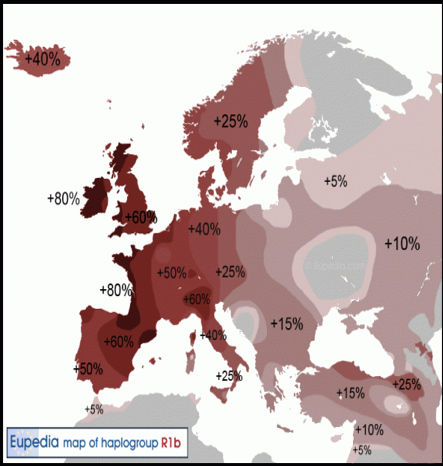
Eupedia map of haplogroup R1b.
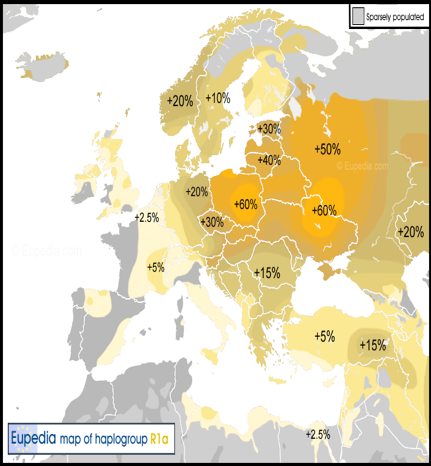
Eupedia map of haplogroup R1a.
European Gene-Pool Haplotype frequencies: the R1b’ and R1a’ Hotspots, a ‘Hand & Glove’ pattern.
The graphs above exclude the other more common European Haplotypes, E1b, I1, I2, G2 & J2)The “R1b” frequency in the island of Ireland is near 82%, while in Britain (most of the UK) it is nearer c.60%+. In central Europe beyond the Rhine, the frequency falls below 50% of European end-Millennium males, and lower as one progresses eastward. Conversely, the geographic footprint of the alternate ‘R1a’ haplotype, is the reverse of the R1b's own Irish-hotspot dispersion pattern. As one progresses westwards across continental Europe, from east to west, the R1a's frequency among the Euro-male population decreases. In the mid-continental Rhineland, its frequency is nearer a 20% figure, in the island of Britain c.10%, in the island of Ireland it is a marginal presence, probably c.1%. These figures above are roughly rounded. They are offered more for illustration and contextual guidance than precise accuracy. Sampling is mostly and more often conducted on regional or border-limited bases. That prism of identification or demarcation may not faithfully conform to the European natural landscape and its ancient human history or transient descriptive terms.
Irish Haplogroup R-M269 (‘PC1’ ProProtein Genetic marker variable, Blood Group ‘O’, R1b-M269 ), European R1b-M269 (RHS)
Regarding yet another common European haplotype, the “I” haplotype (the letter I, as pronounced ‘eye’), an analysis of its continental hotspot gradation and dispersion is somewhat akin to that of the “R1a” haplotype. The frequency pattern radiates from the haplotype “I” hot spots, its peaks, highest on the Eastern European landmass and Scandinavia at c. 25%, with the level of its incidence or density falling progressively as one moves southward and westward across the central European plain. In Britain however, its frequency is more continental at around the same level as the more central European range, c. 20%-to-25%. This would affirm a certain Anglo-Saxon presence on the island of Britain. In Ireland the “I” haplotype is nearer the c. 10% level.
Irish Y-Chromosome Haplogroup Universe: R1b 82%, I1 6%, I2 6%, R1a 21/2 %, E1b1b 2%, G2a 1%, J2 1%.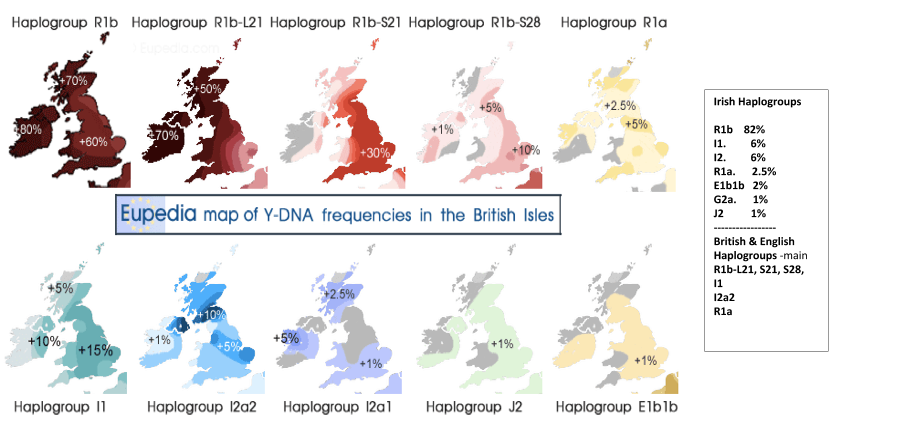
The common DNA marker of the main Sennett surname cohort, the “E-M35” (or “E-L117”) haplogroup (a haplogroup within the broad ‘E1b1b’ haplotype and even broader ‘E1b‘ haplotype classifications), has a very low level presence in the British Isles and Western Europe but shows a rising frequency as one progresses southward towards the Mediterranean and North Africa. The ’E1b‘ haplotype registers very low frequencies in Ireland and in Britain and likewise along the coastal extremities of the northern continent (excepting at the French coast near Calais and Dunkirk). It rises however as it approaches the Mediterranean region. It is common across the arc of the northern Mediterranean, but displays its highest frequency or hotspot on the North African landmass, particularly the ‘Mahreb’ and ‘Berber’ regions of the North Africa continent. The haplotype is also common in all of the eastern Mediterranean, Anatolia and around the edges of the Black Sea. The broad ’E1b‘ haplotype includes smaller generic Sennett subgroups ‘E-M35.1’,‘E-M35’ & subsidiary ‘E-M78’.
Representation of all 3 latter formats just mentioned but in slightly ever-so-different contextual terms are offered here below. Each classification is placed within those frameworks in which they may be most clearly seen. In-between is an illustration of original African migration and the pre-Classical Copper Age around the Mediterranean c.5,000 BC -to- c.3,000 BC.
Current frequency of ancient African & European* broad “E” Haplotype, and the current “E1b” classification
African ‘E’ haplotype, and the ‘E1b’ type (E-M35/E-L117 groups are within E1b type. Note: 2 contrasts of density* @ Paris &Rhine regions)
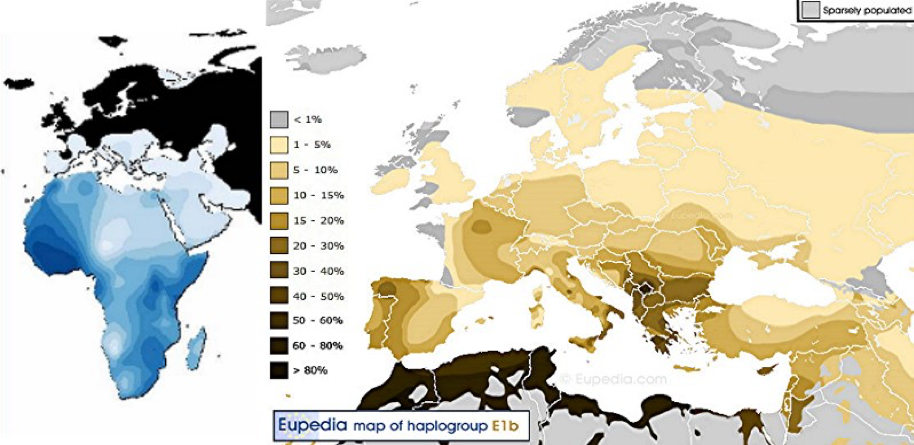
The “E1b” haplotype distribution outlined above has a not too dissimilar pattern to that of the various and successive stages of the long Copper Age, the elongated era preceding for some 4,000 years, the great Bronze Ages, the Early, Middle and Late Bronze Ages. These later Ages were precursors to the shorter Iron Age, that period itself being really an introductory doorstep to the Era of the Classical calendar, a Classical Antiquity within our recorded time.
[From the RHS graphic, one is tempted to say the Roman Republic transferred Balkan troops to Ancient Gaul.]
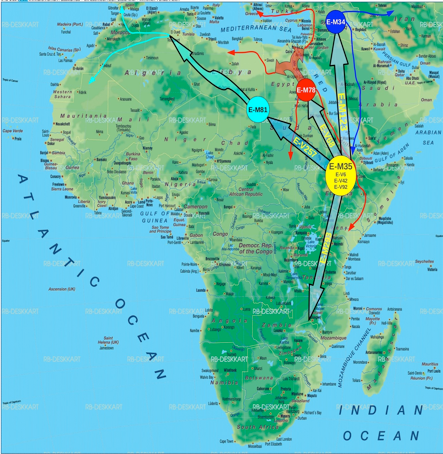
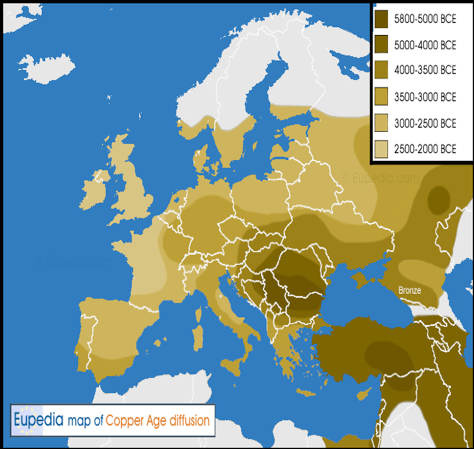
Some further representation of the “E-M35.1” and “E-M35” (E-L117) Haplogroups in the post Paleolithic Era.
National Geographic updated the Y-DNA E1b1b1-M35.1 with a comment "the defining marker of haplogroup E1b1b1 gave rise to marker M35.1, the ancestor of all M35.1, born around 20,000 years ago in Middle East”.
From Middle East 20,000 years ago (note No's 14, & 11, below)

Sennett’ subsidiary Haplogroup ‘E-V13’ is bottom/left.
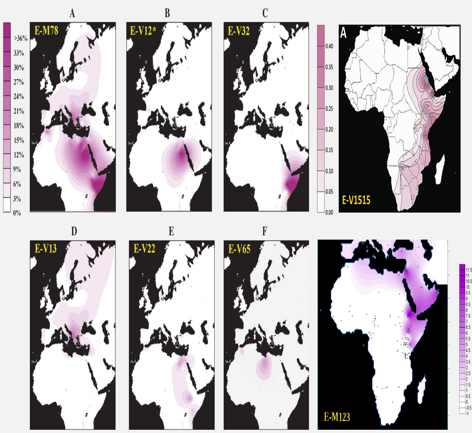 E-M78, E-V13, E-V12*, E-V22, E-V32, E-V65, E-V1515, & E-M123
Full tree
E-M78, E-V13, E-V12*, E-V22, E-V32, E-V65, E-V1515, & E-M123
Full tree
One might say that the distribution pattern of both the wider haplotype “E1b” (broad) and the “E-M35” haplogroup (narrower) markers, surround the Mediterranean & Middle East and also closely mirror in obvious ways the extent of the Classical and pre-Classical Mediterranean, and ultimately the Roman Empire at its peak.
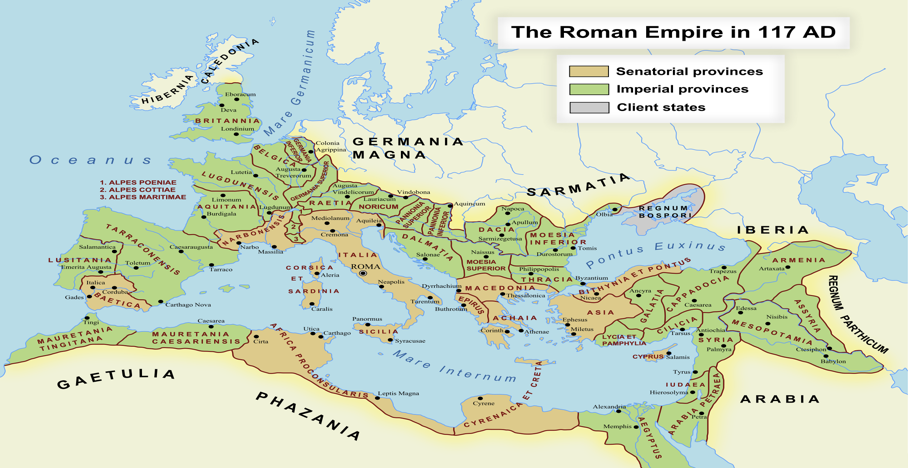
The “E-M35/E-L117”haplogroup sub-classification's “E-V13” frequency, Europe (Western ‘tip’ @ Val de la Sennette)
(Note: This Eupedia chart also appears in large and small format in Chapter 5.2/)
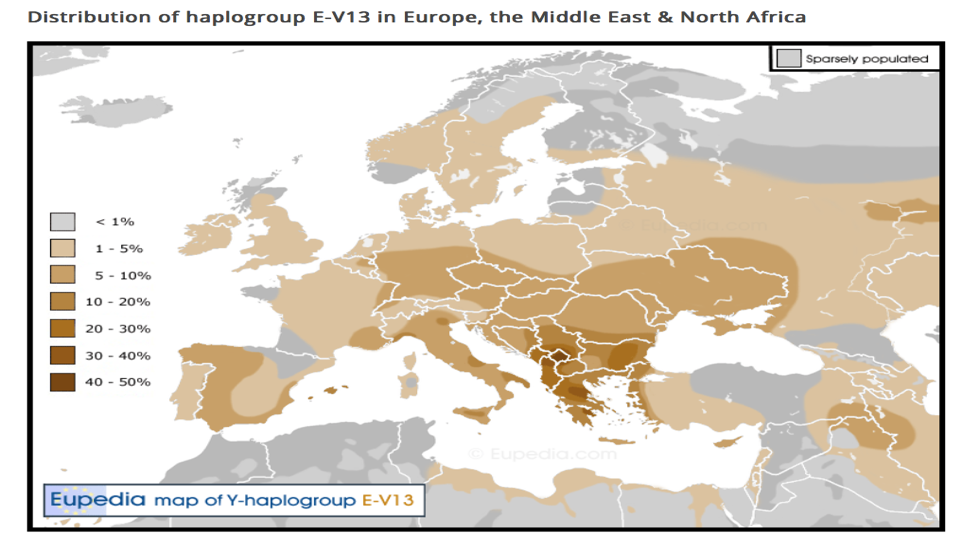
So, in the case of the ‘Sennett’ Y-DNA catchment surname, there are a number of secondary haplogroups. They do not comprise a common Group cohort or a shared haplogroup sub-set. They are therefore unrelated.
The study's un-grouped members comprise those within the catchment surname with a variety of antecedents and mainly an ancestry with some past Irish heritage. The non-core members tested so far have been generally revealed to be individually unrelated elements of the wider and monolithic Irish haplotype “R1b” (mostly within the‘R-M269’ Y-DNA haplogroup). This would be a normal expectation within a broad testing catchment. The ‘R-M269’ marker concerned is a component element within the overall 82% incidence of frequency of the “R1b” haplotype in Ireland. Please note however that this non-core Sennett haplotype demarcation relates only to the test-sample results as so far recorded. The total sample-Group at the present time comprises that number here shown below as the cohort set of Sennett co-named or other-named males. Within this running- total sample figure provided below, the ratio of core-Group (E-M35) to Sennett non-core (mostly R1b-M269)
post-test male members, is currently roughly of the order of 2:1.
The cohort universe of memberhip in Sennett One-Name Group study appears in the box.
c. 40-to-50
It's global members have been tested by the https://www.familytreeDNA.com website.
The existence of this high frequency or homogenous Irish “R1b” haplotype in the Sennett survey sample, and within the wider general Irish population, falls quite easily into line with ancient Irish/Gaelic/Celtic mythology, that concerning a prodigious and fecund warrior, referred to in the Irish-Gaelic literature as ‘Niall of the Nine Hostages’. The mythology is often referred to in genetic circles, it is justified by the Irish “R1b” hot-spot status.
In presentational terms, there is a common practice within modern single-surname Group analysis a tendency to utilise Excel spreadsheet data displays and colourised x/y axis grid arrays. Within this work practice there is a convention to align and display secondary or smaller sub-group analyses of the common catchment surname. These secondary sub-sets should usually share a common surname with the primary group and a common Y-DNA haplogroup marker within its own sub-set. Therefore, one would expect some “non-E-M35” classifications within the overall Sennett core research sample Group. The whole Group is hosted on the site. The non-core classifications should usually exhibit different DNA haplogroup test returns or predictions versus that of the main sample group, the Sennett Group’1 cohort. It would be correct to give a short but compact exposition of the basic elements of the R-M269 haplogroup (aka R1b-M269). This is carried by a number of members of the Sennett cohort in an individual or non co-incident ancestral fashion.
The R-M269 (aka ‘R1b-M269’) Irish/Celtic/Britannic Haplogroup
In an effort to provide a focused collection of graphs to clarify the position of the Irish R-M269 haplogroup (green) in it's proper European context, these few charts below are offered together as simplified illustration.
[Yellow=Haplogroup ‘R1a’, Green= ‘R1b’, Lighter Purple= ‘I’, Sky-blue= “E” haplotype of ‘E-1b1b1’or ‘E3b’]

The Haplogroups more common to the British Isles [Eupedia Map, repeat of earlier above]

Eupedia map of haplogroup R1b(LHS) and R1a(RHS), further below enlarged Eupedia Map Haplogroup R1b



Density of ‘R1b’ Haplogroup in Europe
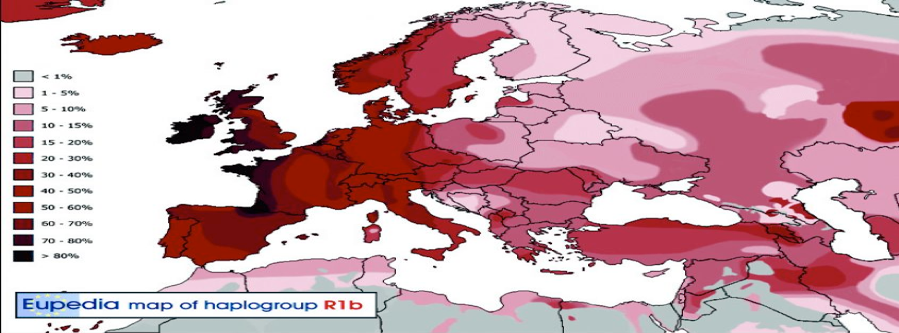
Some Irish Genetic Markers: ‘PC1’ ProProtein Genetic marker variable, Blood Group ‘O’, Haplogroup R1b-M269, (repeat of earlier)

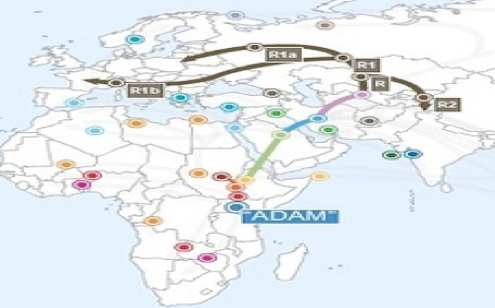
 Red Europe .png)
The wide E-M35 (E-L117) haplogroup and its “E-V13” subsidiary classification:
The “E” haplotype is scientifically classified as an African haplotype (like many), and the marker indicates an interesting more distant history. Perhaps it is better to say that the “E” Haplotype is African in a very very ancient sense, rather as an “E-M35” or an “E-L117” or an “E-V13” Haplogroup is very ancient in a pre-Classical Balkan sense. It may therefore be appropriate to briefly go back to first principles of Genetics just to clarify and contextualise what follows in this paper. The Sennett Group1 haplogroup classifications (the main E-M35, E-L117 and recent E-V13 haplogroups) and the shared but also quite un-related R-M269 variations have been hopefully already illuminated within the presentation. The possible subsidiary and sub-clade classifications that may in time become evident in a ‘nearer’ past, nearer in time than the E-V13 terminal haplogroup within the sample cohort, will be outlined in the Conclusion Chapter 5.2/ segment. The actual sub-clade clarification is a work-in-progress and of the future. The origin of the E-V13 descendants as generally accepted, occurred after the Neolithic Era and after Neolithic farmers moved to the Balkan and Danube basins, around 3,500 BC .
Basic Genetics
Briefly and as a precaution one might mention the fundamentals that were not perhaps clearly stated in this early section of the 1st Chapter. One has not as yet addressed or outlined the basic genetic tree and the impact of different waves of ex-African dispersions or demographic factors on what we now call our haplogroups. To some extent a set narrative is quite un-necessary at this point. Many of the accessible graphics available today speak so wonderfully for theselves and require no human hand or intervention. It can be sometimes best to say or write nothing in life, opportunities all should be ever happy to take. Here the basics of our genetics will sing for themselves until the thread need be picked up again some way later in Chapter 5.2/.
The genetic marker universe has many alpha-numeric names. Accordingly, it was determined some years ago, by the authorised familytreeDNA Single-Surname Study Group (the Sennett Project), that among the modern-day Sennetts tested to date, the most commonly registered Sennett haplogroup (that of the familytreeDNA's mainstream Group1 Sennett-cohort), was the “E-M35” and later the “E-V13” haplogroup outlined above. For historical reasons the haplogroup was also given the “E-L117” label (a coded nomenclature). These groupings really define and refine the same set of specific genetic markers. The “E” haplotype is scientifically one of the African continent's many direct haplotype genomes, the source of all of our ultimate origins (as stated earlier). All the c. 26+ official haplotype classifications of modern genetics, are ultimately African alpha-coded groups.
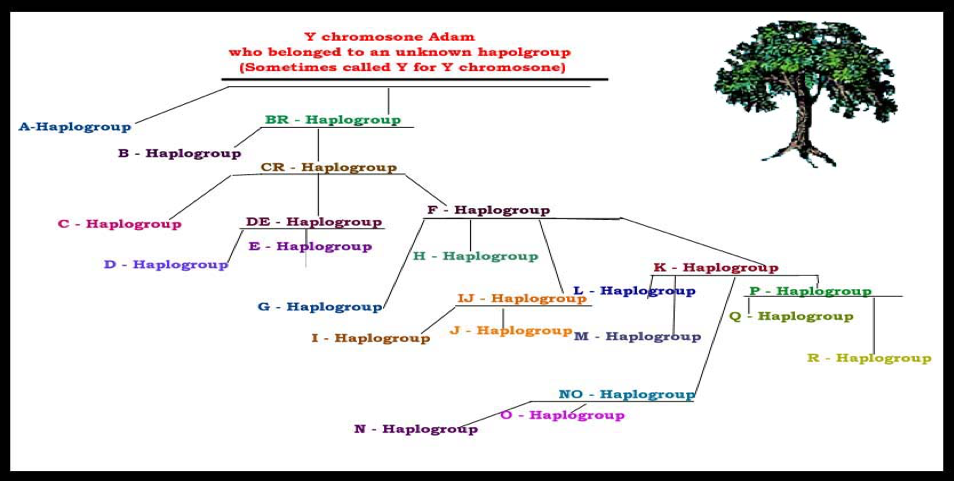 Haplotype ‘E’ in Africa, and later the ‘E-M35’ in ‘Horn of Africa’, and even later ‘E-M78’ & ‘E-V13’ in Mid-East
Haplotype ‘E’ in Africa, and later the ‘E-M35’ in ‘Horn of Africa’, and even later ‘E-M78’ & ‘E-V13’ in Mid-East
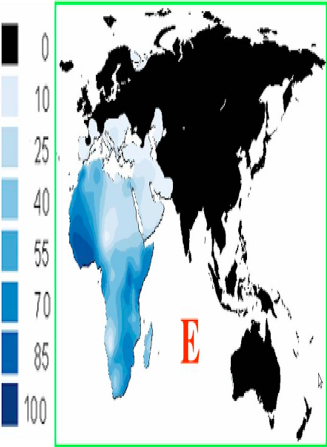
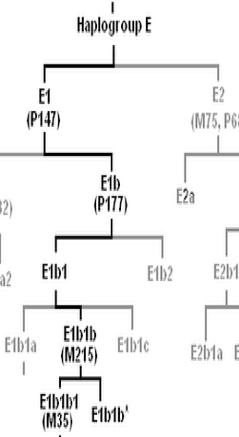
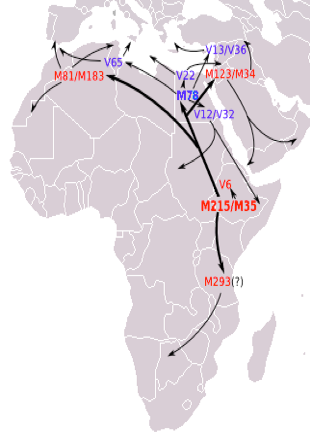
Some “E” haplotype history in Europe:
The Sennett associated “E” prefix classification has followed the established process of scientific, professional and academic classification of the haplotype and its many sub-set haplogroup test samples. The frequencies and sampling territories of the earliest tested individuals, as recorded in early stage research studies, lead to its North-African and Afro-Mediterranean classification. So for this reason the Sennett marker haplogroup is coded with the “E“ (African haplotype) prefix classification. The modern Y Chromosome genetic classification conventions and standards have been fully observed in establishing these chromosomal DNA names and labels. The process utilises the sampling-test means of ‘STRs’, also known as ‘Short Tandem Repeats” (or Simple Tandem Repeats). These are repeats of short ‘A/T/C/G’ genetic chain sequences. We all, one supposes, are truly, fundamentally and proudly African of course. The “E-M35 (E-L117)” & “E-V13” haplogroup markers are quite rare in Ireland & Britain but increase substantially as one progresses southward through the European continental landmass, and then across the Mediterranean to the North African coast, the northern region known as the Maghreb and the sands and lands of the northern Sahara and the Berbers.
“E-V13” haplogroup in Greece, and estimates of preceding parent haplogroups (E-M35, E-M78), in East Africa.
Timescale of Origins: E-M35 (pre-11,000 BC), E-M78 (10,000-6,000 BC), E-V13 (5,000-3,500 BC) post-Neolithic/Copper Age
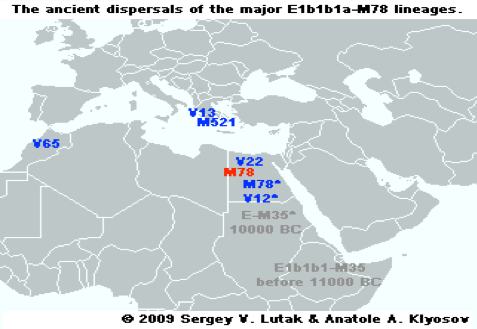
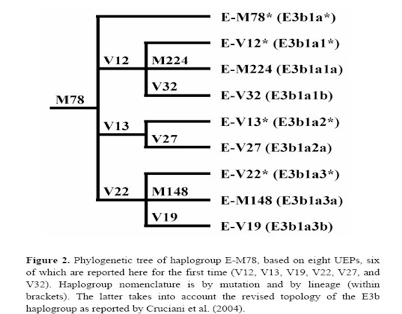
Therefore because the Irish and Scottish experience was unusual in Europe, there must be another vector or carrier of the “E-V13” haplogroup which imbedded long ago in Ireland/Scotland (excluding early wave mass European migrations, the slave trade, matrimonial relocation or aberrant and maverick bachelor wanderings). In these circumstances the “E-V13” classification confers no particularly higher likelihood to either of the Anglo-Saxon or Flemish cases for origin. The haplogroup could have been carried by Roman or earlier migratory groups to procreate within both hosts and integrate within both cultural envelopes. This is to say that the haplogroup was absorbed by either the Angles or Frisians ‘etc’ on the continent, or in Britain, or alternatively by the endogenous Flemings in Flanders. Roman culture left many remnants in its wake. It was expansionist through absorption of Britannic and Celtic Britons under its rule into a Roman society. There was then, thereafter, the post-Roman absorption of some indigenous British populations by a later Anglo-Saxon supremacy. The circumstances provided ready means to inherit an Afro-Mediterranean then European, E-V13.
1.3/ Sennett: A Hiberno Cambro-Anglo/Norman-Flemish surname (Flanders in Belgium/France)
One might best perhaps insert some dates among the prefixing adjectives collectively listed earlier above. In doing so one injects a sense of time into describing the path of the surname's history, and the course or trajectory of the individuals who carried it. There are 3 (maybe now 4), important dates, in reverse order 1170, c.1108 and 1066. The concurrence of the 3 dates over a period of 100 years within the last Millennium, might justify the attribution of the term Hiberno-Flemish, as earlier mentioned. Nevertheless, each of these 3 dates can be inserted sequentially into an elongated descriptive sequence as follows …
Hiberno -1170- Cambro -1108- Norman -1066- Flemish,
Hiberno -1170- Cambro -1108- Anglo/Norman -1066- Flemish,
Hiberno -1170- Cambro -1108- Anglo/Norman -1066- Flemish AD|BC
Hiberno -1170- Cambro -1108- Anglo/Norman -1066- Flemish AD|BC
Hiberno -1170- Cambro -1108- Anglo/Norman -1066- Flemish -AD|BC-
: Anglo-Norman can replace Norman,
: latest testing suggest time period addition
: testing also suggests a regional addition,
: in Illyrian/Balkan region of Roman Empire.
Illyrian/Balkan: date ‘correct & imprecise’.
- British -1850- Hiberno -1170- Cambro -c.1108- Norman or Anglo/Norman -1066- Flemish(Fleming/Flemyng)
- American -1850- Hiberno -1170- Cambro -c.1108- Norman or Anglo/Norman -1066- Flemish.
- Canadian -1850- Hiberno -1170- Cambro -c.1108- Norman or Anglo/Norman -1066- Flemish.
- Antipodean -1850- Hiberno -1170- Cambro -c.1108- Norman or Anglo/Norman -1066- Flemish.
- Australian -1850-Hiberno-1170- Cambro -c.1108- Norman or Anglo/Norman -1066- Flemish.
- European -1850- Hiberno -1170- Cambro -c.1108- Norman or Anglo/Norman -1066- Flemish-Roman-Illyrian.
- Hiberno -1170- Cambro -c.1108- Norman -1066- Flemish - Roman -AD|BC– Balkan/Dalmatian.
Most of the lines immediately above might fairly or fully represent the surname's history over two millennia. However, surnames only came into common usage in Britain and France from the 12th Century (Ireland slightly before). These terms represent the sequence of identities one can extract from the latest Y chromosome evidence.There are grounds to justify addition of the 4th date, one prior to those mentioned earlier above. One can not really be too specific about this earliest appropriate 4th date. One can be more sure of the general location concerned. There was a migration (solo or en masse) at some point to Flanders, from Balkan lands.
The most likely period one could associate with this re-location (abruptly or gradually) would probably be near contemporary to and probably either shortly before or after, the time of the birth of Christ (Jesus of Nazareth). In all probability it would be safer to say that the geographic ‘jump’ took place between firstly, some point before the ascendancy of Ancient and Classical Greece in the Hellenic period of the 1st Millennium BC., and secondly, a nearer end-limit set after the long span of Roman supremacy either side of Christianity's birth. The earlier 1st stage of the Roman Republic's period was between c.500 BC. and Emperor Octavian's (aka Augustus Caesar) assumption of power in 27 BC. The great Roman General’ Scipio destroyed its main Mediterraenean rival, the Phoenician City of Carthage (in Tunisia) after 150 BC, and Julius Caesar had conquered Gaul (France) by 50 BC. Augustus was followed by the expansive Roman Empire period proper. The Roman Empire could be considered to last until either of 2 dates, as end points, the two dates 80 years apart.
The first terminal point for the end of Empire was its division into Eastern (Byzantine) and Western (Roman) Empires in year 395 AD. The alternate date for the end of Empire was when the Western Empire's ruler, Romulus Augustulus, was deposed by the Germanic ruler, King Odoacer, in 476 AD. One could say of these latter 2 book-end dates, representing a collapse of Roman rule, that they are acting as proxies for an end limit threshold when a Balkan ancestor in ancient Illyricum (the Balkan region, Roman Dalmatia or Moesia), may have removed to central Europe or the northern continental borders with Germanica, for mercenary purposes.
The various ‘long-window’ threshold dates above mentioned are really so as to roughly gauge or delineate a necessary or reasonable time frame for any likely migratory movement. The starting point of a limit to an historical Balkan migrant's existence probably precedes the Classical Greek civilisation. The high point of Classical Greece was in the middle of the 1st millennium BC. There is not much one can say of such early ancestral origins begun so far back in antiquity. There existed most probably some progenitor's Illyrian ethnic grouping, of a sort, long before Hellenic Civilisation proper began. It was probably living before establishment of the Classical Greek City States or Roman Republic, living somewhere in what would become Illyricum, those Roman Provinces of Dalmatia, Pannonnia, Moesia, Macedonia & Thracia, maybe even some 1000+ years BC.
1.4/Cambro-Norman-Flemish case for Sennett Origin [Wales, England, Normandy & Flanders] (and additionally, 1.4a/ Flemings and Flanders, and 1.4b/ Flanders in the year 1477 and thereafter)
It is a fortunate or unfortunate reality that there are 2 possible real origins for the Sennett surname. It may be a case of a surname's common convergence from two or more separate and unrelated origins. This is known within surname typology as a polygenetic surname. It is not unusual, it is certainly possible, though as yet unproven. The surname's Wexford concentration and frequency in Ireland is a result of a sequence of historical events. This perspective encompasses in reverse order, the Norman Invasion of Ireland from a Flemish-Welsh-Norman colony in southern Pembrokeshire (Dyfed) in South Wales after 1167, the establishment of that substantially Fleming populated settlement in the area of South Pembrokeshire in the early 12th Century (c.1108), and before that, the preceding Norman Invasion of England by Duke William the Conqueror of Normandy with his Flemish and Breton allies and mercenaries in 1066. Duke William had married his dear spouse the Princess Matilde in 1051. The Princess Matilde was well connected, she being the daughter of Baldwin V, Count of Flanders, and a grand-daughter of a former King of France, Robert II.
These events convey a certain joint Cambro-Fleming and Anglo-Norman character to the surname before its arrival in Ireland. The invasion of Ireland was Norman in leadership and character, and so English or Anglo-Norman in that sense, but not English in the sense of it being Anglo-Saxon in nature. That would not be true. There may not have been many or any Anglo-Saxon elements within the early Irish Invasion fleets. All the above terms or their collective terminology, are really sequential in timing. They are accurate and properly correct in a descriptive and historical sense. They explain the source of the surname and its consequent and later clustering in Ireland. There seems to have been a consistent conflation of the two potential sources of the surname, and of the identity of the early Invasion period and post Irish Invasion population transfers, in 19th Century and 20th Century surname dictionaries.
However, although it may seem less likely that there can be a second origin (a polygenic origin), or two conflicting surname origins each one being from a separate and unrelated source, as was said it is a possibility that such a co-incidence can arise. The representation of the surname (no matter how it may be spelt) post-12th Century, in the surviving and extant archive records, defines a co-incident surname origin beyond the continent of Europe. Firstly and more certainly, among the Cambro-Flemish sub-Anglo/Norman mercenary group in Ireland on one hand, and an Anglo-Saxon pre-Norman Conquest incidence of habitation in England, on the other. It is very possible that subsequent to both invasions (of England, and then Ireland, 100 years later), there has been a common convergence in the surname spelling or the received surname nomenclature. The duality arises from its recorded manuscript presence in both islands in the centuries immediate to, and then following the turn of the 12th Century, c.1200.
The surname presence in South Leinster in Ireland indicates the probabilities of the surname's military course and its trajectory, this movement and relocation dictated by event-driven large population flows. The migratory pattern is one of drift towards Wexford County, either directly from outside Ireland around the years 1169/1170, or otherwise from inside Ireland, from Kilkenny County, around years 1200-to-1205. So it might be said that the descriptive terms represent the migration of a specific body of an identifiable Flemish speaking or Francophone and Gallo-Fleming people or persons (or person) at three different points of time. Firstly, in or about the years 1066 to England, thereafter to South Wales in the early 1100's (c.1108), and finally then to Waterford and Wexford c.1170. The descriptive terminology of Cambro-Norman-Flemish for the Sennett surname fully captures and conveys a gradual vicarious progress towards its arrival in Wexford*. In Wexford the name stuck!
The Flemish descriptive term as applied within the wider Cambro-Norman-Flemish force that invaded Ireland may need to be clearly justified and articulated. The Norman Conquest of England had originally included French, Fleming (from Flanders) and Breton (from Brittany) mercenaries who accompanied Duke William of Normandy as allies in 1066. The Duke's spouse was the Princess Matilde of Flanders (1031-to-1083). Matilde was daughter to the Count of Flanders, Baldwin V, and his earlier widowed spouse the Countess Adèle also known as Adela Capet. The Countess was herself daughter to the King of France, Robert II (972-1031), the 2nd French ruler from the House of Capet. The House of Capet gained control of Normandy in the early 1200s.
The Fleming Mercenaries in Britain after the Battle of Hastings in 1066
The mercenary Fleming sub-group, it is estimated, comprised some 50 or more Knights and men-at-arms at a minimum (it might also have possessed a military specialism in archery). The group most probably remained in England for some time after the Conquest. The sub-group was later divided, many of their more aristocratic leadership dismissed to Flanders, and the remainder encouraged by the newly reigning King (King Henry I, reigned 1100-to-1135, 4th son of Duke William the Conqueror), to remove to South Pembrokeshire in Wales. This transplantation occurred most likely sometime between or after 1106-to-1108. While in England these military men, a mercenary group really and somewhat distinct from William's de-jure Norman aristocracy, must have retained some character of Flemish identity. Their particular identity was one that was by definition recognisable to the new King, and one not entirely trusted by him not to align with any potential rivals in England, Scotland or even Wales. The King proposed the relocation to coastal South Pembrokeshire and Gower, including the area around Haverfordwest and the ports of Pembroke and Milford Haven. This plantation would facilitate control of the important far Welsh coast, and help consolidate the new Norman territories along the Severn Estuary and in the Welsh Marches of south east Wales. It would also distance the mercenary Flemish group, allies of the King's deceased mother (Princess and then Queen Matilde), from the Royal Courts in France and London.
Strongbow's Norman Invasion of Ireland was launched in August 1170 from South Pembrokeshire, the embarkation point being from Milford Haven, nearby to the port of Pembroke itself. Strongbow landed at Waterford where he married Aoife, daughter of Dermot McMurrough King of Leinster, in October 1170. He advanced by progressing firstly to Dublin. The first record of a Sennett individual in Ireland, by the name Sinath or Sinad, was in Kilkenny in 1204 (Graiguenamanagh/Duiske). Soon thereafter, the surname would be found mainly in Wexford County. Once rooted in Wexford, it would remain associated for many centuries thereafter with the County's Flemish sub-group, an ethnic (or ghetto) grouping within a new ruling Norman ascendancy.
[*An interesting aside here is that the term “Cambro-Norman-Flemish”, as applied to the South Wales ‘Pembrokeshire’ colony, might also describe the distinctive spoken dialect ‘Yola’, adopted as the vernacular speech and script of South Wexford. It was probably spoken with fluency in South Wexford, from the Norman Invasion (1170) until after the Cromwellian confiscations (1650's), and to some lesser form up to the early/mid 19th Century. The Yola vernacular was endemic in the southern coastal Norman baronies of Wexford (Bantry, Bargy and Forth). It remained the region's main tongue for that 500 year period prior to Cromwell's ultimate re-conquest of Ireland of 1649-to-1652. The dialect was most probably an unlikely mixture of Norman French, Middle English, some Flemish and Welsh, and eventually maybe a little Irish-Gaelic. It might well alternatively have just been a preserved version of South-Pembrokeshire Chaucerian-type Middle English (although it predates Chaucer himself). It survived in some form of use in Wexford until the mass education of the mid 19th Century. Similarly, there is an undercurrent of an historical dialect in Northern Ireland, that of Ulster Scots in Counties Antrim and Down (Ulster-Scotch in its own vernacular), a dialect known also as ‘Lallans’ in the Scottish Lowlands and Borders. Please see 2.3/ Appendix.]
1.4a/ Flemings and Flanders:
At this point it may be useful to place the Flemings in an historical context in some way. They most certainly possessed a wanderlust. Given the long extent of their sojourn in the British Isles they seem to have suffered little yearning for home, looking to the future rather than back to their past. Some time after Duke William's Invasion of England, many of their top layer of aristocracy and leadership were dismissed back to Flanders This was probably for fear of unlicenced interference in the King's and State affairs or the fact that they may have been a challenge to confident control. One must presume therefore it was the less well connected dregs in the cellar that were held back to provide some more ‘vin de table’ service towards the fundamental ‘force de majeure’ of William's still troubled and fractious realm. It was not always so. There are many reports of contemporary textile or linen workers crossing the modest 20 miles of the nearby English Channel (at the Calais-Dover crossing) at one point or other (before and after the Conqueror), and for one reason or another. It does not stretch the imagination to believe such inter-coastal drift could be true. One might also hypothesise that any earlier phase Flemish textile workers in England, who may have encountered local opposition from indigenous populations, may have been similarly planted to South Pembrokeshire. The end destination, whatever the cause of migration, would be the fair but far away English colony in South Pembrokeshire. One might ask however, why did’nt Flemings just walk to another continental city in times of threat or devastation, what is sometimes referred to nowadays as ‘getting on their bike’. One must conclude that for some reason the Flemings (most certainly men and women alike) were wanted and were valued in their near neighbouring English or Anglo-Saxon Kingdom. That fact might have held excluding even King William and Matilde of Flander's matrimonial and broader whole-family bonds in the newly contested Kingdom of England post 1066.
1.4b/ Flanders in year 1477 and thereafter
One might just briefly observe below the tangled historic knot of identities and political allegiance enclosing if not quite surrounding the Comté de Flandres (the old County of Flanders) in the modern northern Belgium of that late medieval period.
Flanders 1477(orange) & 17 Dutch Provinces: (River Sene/Senne @Hainaut No.5),Low Countries 1514-1579